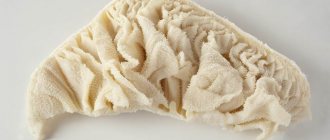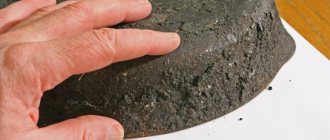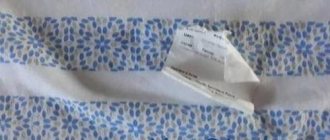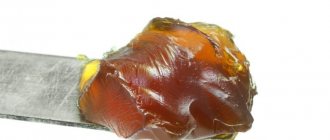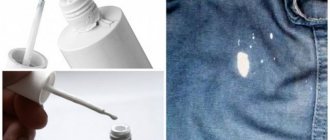03/17/2017 Stains
How to remove a thermal adhesive from clothes if it is cracked, frayed or simply tired? It happens that an item fits just perfectly, matches the style and color, but a tasteless print in the most visible place spoils the whole impression of it. What to do?
Give the item to those in need, throw it in the trash, not buy it - or try to give the clothes a new life by getting rid of the ugly sticker? There are several ways to remove prints from different materials from different types of fabric - one should probably work for you.
How to remove print from a T-shirt
The choice of method depends on the type of print. Rhinestones can be removed using a hot iron. Place the fabric on top and place a hot iron on the fabric, then quickly use the same fabric to collect all the rhinestones from the surface of the T-shirt. Alternatively, after multiple washes, rhinestones can be removed with a regular spatula. You need to work with a spatula carefully so as not to damage the fabric. You can pre-freeze your clothes in the freezer.
T-shirts with a thermal printing design will benefit from:
- alcohol;
- hot iron;
- freezing;
- solvent.
Apply alcohol using a sponge, having previously soaked it. We go over the entire surface with swiping movements. We send it straight to the wash. Dry, if necessary, the procedure can be repeated.
When using an iron, heat it up, place the fabric on top of the thermal pattern and then iron it with a hot iron. The design should remain on the fabric surface or paper napkin.
Freeze clothes for 6 hours. After this, we go over the surface with a spatula.
The solvent helps in removing all types of stickers, but it must be used carefully. First try removing it on a small piece of the thermal pattern.
Typically the type of sticker is located on the label of a sweatshirt, sweatshirt or other clothing. If not, then the following tips will help:
- Thermal stickers are distinguished from others by the variety of colors and tints. The fabric is not visible under the sticker, the texture is dense. When ironing, do not touch the area with the thermal adhesive;
- if thermal printing was used when applying the design, then in this case the texture of the design is not dense and the fabric of the product is visible through it;
- When screen printing, it is impossible to get rid of the design; the layer of paint is applied quite thickly, and the paint seems to eat into the fibers of the fabric. Therefore, either continue to wear such a product or get rid of it;
- Vinyl stickers usually consist of a dense base. Chroma is approximately two colors at the same time. The fabric is faintly visible through the pattern.
Adviсe
The process of removing the pasted pattern will be more successful if you take into account some nuances.
The main recommendations are as follows:
- Don't try to remove fresh stickers. They adhere very tightly to the fabric and it is difficult to remove the adhesive base.
- Before using any method, clothes must be washed and dried. Washing and drying are also required after complete destruction of traces of the image.
- Before choosing a cleaning method, you should study the composition of the fabric and the sticker itself.
- During processing, the item must lie on a horizontal surface. This will prevent the cleaning liquid from spreading.
- It is advisable to test a new pattern removal product first on a small, inconspicuous area of fabric.
You can learn how to remove glue stains from clothes here. Read about removing traces of glue from a sticker on fabric here.
How to remove sticker glue from clothes
After using a spatula, sometimes traces of glue remain on the surface of the product. To remove the glue, you can use alcohol, solvent or dishwashing detergent. Before choosing one method or another, pay attention to the technical conditions for washing on the clothing label. It may be that it is unacceptable to use aggressive chemicals. Then you can use dishwashing detergent.
You can also remove the glue by first freezing the clothing in the freezer and then scraping off the residue with a spatula. Then wash in hot water and dry.
Method 2. Chemical solvents
Another effective way to safely remove stickers from clothes is to use special products - they can be easily purchased at a household chemical store. Instead of special cleaners, you can use nail liquid, glue remover, or alcohol. Before using any of the above chemicals, you should check its effect. To do this, you need to apply the product to an inconspicuous area of the fabric and wait for the result.
Next, it won’t be difficult to peel off the picture:
- The product must be placed in the dryer and the device set to high power for several minutes. Exposure to high temperature will make the sticker moveable.
- The item must be turned inside out and placed on a flat surface. The drawing should be on top, but on the wrong side.
- The drawing must be treated with the previously selected product so that the liquid completely saturates the material with the picture.
- The solvent will penetrate deeper better if, after applying the product, you slightly stretch the fabric in width. After this, you need to distribute a little more product onto the problem area.
- Using a knife will not be difficult to scrape off the sticker.
- The remaining glue should be treated with alcohol, which will make getting rid of the adhesive base much easier.
- At the final stage, the item must be washed in a machine or by hand, separately from other clothes. This precaution will remove chemical residues from the material.
How to remove writing from a T-shirt
A small inscription from a T-shirt is removed using a hairdryer operating at maximum temperature. Place a thin cloth on top of the inscription inside and outside to create a thermal effect. Then remove the print using a spatula.
You can use a steamer. The removal process is the same as when using a hair dryer.
Method 3. Cold
You can get rid of thermal stickers using the freezer. Cold promotes glue transformation. Due to exposure to low temperatures, the glue gradually dries out and begins to bond the pattern with the material worse. In order to remove the thermal sticker, just set the freezer to the lowest temperature. Then you should put the item in the middle for at least 30 minutes. After the glue has dried, you should carefully remove the drawing.
How to remove rubber labels
These are more voluminous images and denser in texture. You can try to remove it by scraping it off with a metal spatula. Typically, such stickers are not glued tightly, just for the purpose of being able to easily get rid of them.
And the option is to heat it with a hairdryer so that the glue under the label heats up to a liquid state, then all that remains is to remove the sticker, and then get rid of the remaining glue.
Method 1. High temperature
Using a regular hair dryer or iron, you can get rid of the thermal sticker. This option requires a significant investment of time, but the result is worth it. Before using high temperatures, you should read the label on the clothing. For example, polyester is afraid of strong heat, because of which the material may begin to melt.
The main task is to melt the glue. To do this, a stream of hot air is directed directly at the sticker, and a hairdryer is brought as close to the fabric as possible. After some time, the sticker will begin to peel away from the material, so you can try to remove it.
To protect the inside and second layer (for example, the back of a T-shirt), place a towel or other absorbent and fairly thick fabric inside and under the garment. If the place from which the sticker is removed is too narrow, you can use cardboard instead of fabric.
It is quite possible to use an iron instead of a hair dryer. To do this, place a damp towel on top of the design and place the iron on it. If the iron-on adhesive is vinyl, then you should put parchment between the item and the towel, onto which the design will be transferred during ironing. High temperature will soften the glue and have a beneficial effect on the result.
After the sticker has softened, it must be carefully scraped off with a knife, starting from the edges. A similar procedure with an iron and a knife should be repeated until the thermal sticker can be removed from the clothing. When the result is achieved, glue may remain on the material. It can be easily removed using a special glue remover or alcohol. Before using the product, it should be tested on an inconspicuous area of clothing.
Advice! The newer the thermal adhesive, the easier it is to remove. Fresh glue is much easier to remove than old glue.
If you are not sure that you will be able to remove the softened sticker with a knife without cutting the item, you should use soda. After treatment with a hairdryer or iron, the item is soaked in a weak soda solution. This method will allow you to soak the drawing. Before wearing the item, it should be washed in the machine.
Scotch tape - is it possible to remove a sticker with it?
You can also remove the sticker using regular tape. To do this, you need to glue the tape to the surface of the sticker and iron it with your hands for two to three minutes (we create a thermal effect). And then, using tearing movements, we peel off the drawing.
When using any of the methods, the drawing may not be completely removed. In this case, you can replace it with another sticker of a suitable texture. Iron-on adhesives are easy to apply, vinyl ones are a little more difficult. But this will serve as an excellent solution if you are tired of the old faded print that could not be completely removed. This can happen due to wearing the product for a long time. The fresher the sticker, the easier it is to remove from the surface of clothing.
It is important to consider the fabric of the product itself. For example, using tape is not suitable for thin fabrics that are subject to stretching. Fabric that is too thick will also require additional effort. A T-shirt or sweater that fades will not tolerate aggressive liquids such as alcohol or solvent. In any case, it is necessary to use several methods to remove stickers or glue after them, as well as rhinestones, in order to achieve the best effect.
Types of stickers
Appliques on things not only serve as additional decoration, but also help make them recognizable. For example, a sports team logo or a sign on work clothing shows a person's affiliation with a group.
The following types of stickers are distinguished:
- Iron-on adhesives. Thermal film is made from polyurethane film or polyvinyl chloride: on the front side there is an image, and on the other side there is a special hot-melt adhesive that sticks to the fabric when exposed to high temperatures.
- Vinyl patterns. At home, they can be removed using an iron and steaming, but there is a high risk of residual marks.
- Ornaments and patterns painted with paint. As a rule, alcohol-containing products can cope with them.
- Rhinestone stickers. The sparkles can be easily removed by hand, but they leave a trace of glue behind. It can be reduced with a solvent, alcohol or special means.
Attention! Before applying the sticker, you should read the instructions for use so as not to damage the fabric.
Alcohol
When using medical alcohol, do not be afraid of ruining the item.
It will not happen. Alcohol gently removes traces of glue from the fabric without damaging the structure of the material. How to remove remaining glue or sticker:
- Pour rubbing alcohol into a separate container. After use, it cannot be used as a wound disinfectant; it will have to be thrown away.
- Dampen a foam sponge with it. Wear rubber gloves if your hands have microcracks or other damage. If alcohol gets on the wound, it will cause a severe burning sensation.
- Treat the desired areas of clothing with this product. Don't skimp on alcohol. you can pour it into a spray bottle and spray the composition on the sticker.
- Leave the item to dry.
- When the T-shirt is dry, rinse it in warm water. Don't take off your gloves. The alcohol has been absorbed into the fabric and will come out with the water.
- Next, wash the product with laundry soap.
You may not be able to remove the sticker from clothing this way the first time.
Medical alcohol is used to remove inscriptions from both light and dark products. It does not discolor fabric or bleach.
How to remove sticky adhesive from other materials?
To remove traces of glue, it is important to consider the material on which the sticker was glued. A variety of cleaning methods are used
Tools used
The adhesive base can be removed manually using detergent.
If this does not help, then use:
- oil: sunflower, corn, olive;
- alcohol;
- vinegar;
- scotch;
- acetone;
- household hair dryer;
- citrus.
Oil
The method is suitable for surfaces that do not absorb fats.
Sequence of procedure:
- The label is soaked in oil and left for 10 minutes.
- Soaked paper is removed with a knife or plastic scraper.
- The product is washed with soap and water, and the remaining glue is removed.
If the house runs out of oil, you can take 20-40 g of mayonnaise.
Alcohol
Use pure homemade alcohol tincture
Use pure homemade alcohol tincture, store-bought vodka, deodorants.
Procedure:
- A cloth napkin is soaked in the composition.
- Wipe off the adhesive base.
- Rinse thoroughly with hot water.
This method is not suitable for all materials; you should first check it on an inconspicuous fragment.
Vinegar
Suitable for most surfaces, it does not contain “aggressive” chemicals.
Algorithm of actions:
- Apply table vinegar to a cloth.
- Wait 7-10 minutes: the paper will become limp during this time.
- Carefully remove the top layer.
- The glue is wiped with a wet cloth.
If the procedure does not help, repeat several times until the adhesive stain completely disappears.
Scotch
This method will help when the sticker is “fresh” and can be easily removed. Tape is glued to the top and torn off with a sharp movement.
The procedure is carried out several times, rinsing the remaining adhesive base with water.
Acetone
Solvent and a hair dryer will help in the fight against factory price tags. The label is heated with hot air and removed with a scraper. The remaining adhesive base is wiped off with a cloth soaked in acetone.
Hairdryer
Suitable for metal and durable materials.
Procedure:
- The surface is heated.
- They take off the price tag.
- Soak in oil or fat and leave for 10 minutes.
- Wash with detergent.
A household or hair dryer is suitable for warming up.
Citrus
You will need several lemons to remove the paper. The label is soaked in lemon juice and left for 10-20 minutes. The paper is removed with glue and washed with soap base.
Removing stickers from clothes
Using an iron or hairdryer, heat the required area.
It is possible to remove price tags from items at home.
A few common options:
- Using an iron or hair dryer, heat the required area. A cloth is placed on the clothes so as not to spoil the surface. It is also necessary to read the composition of the fabric: some materials should not be subjected to heat treatment.
- Use nail polish remover without acetone. The sticker is carefully impregnated with it. But it’s worth checking first on an inconspicuous area of clothing, otherwise your favorite item may lose color.
- Clothes are placed in the freezer for 25-40 minutes. During this time, the glue “dries out” and the thermal pattern is easily removed by hand.
To remove the sticky layer, use tape, laundry soap and detergents.
From furniture and wood
The adhesive layer must be removed especially carefully if the furniture has a polished surface. Careless actions will lead to damage to interior items.
It is important to choose the right cleaning method:
- Heat treatment. The sticker is heated with a hairdryer for several minutes. The edge is lifted with a flat plastic object. Moisten a cloth with a polishing solution and wipe the surface of the furniture.
- Sunflower oil. The paper is moistened and left for several minutes. Scrub with a plastic object (knife). Furniture is wiped with soapy water.
- Aerosol. Spray on adhesive paper and leave for 2-3 minutes, then remove. It does not harm furniture and polishes the surface.
Old stickers are left for 10-15 minutes and soaked in alcohol.
From metal
Peeling the sticker off metal products without leaving a trace is not difficult. The methods listed above are suitable for this.
Means and materials for processing:
- hair dryer;
- vinegar;
- solvents;
- industrial products;
- oil;
- lemon juice.
- alcohol;
- alcohol.
The metal surface is durable and therefore difficult to damage.
Method 4. Scotch tape
Another effective method for dealing with a boring or faded pattern is the use of tape. Using this option will not be difficult to remove the sticker, but it is not recommended to use it on delicate fabric that can stretch. The process of dealing with a picture is that pieces of tape are placed one after another on the problem area, pressed tightly and abruptly torn off. This manipulation should be performed until the full result is achieved.
Special products from the store
Information for those who do not want to delete images themselves using the methods listed and do not have the opportunity to turn to professionals.
There are special tools for removing pictures:
- Thermal sealer is a spray for removing thermal stickers and traces of them. The can must be shaken, applied to the drawing on both sides, wait 1 minute, and remove the image. This product does not damage the fabric, acts quickly and is suitable for all types of stickers.
- Goo Gone - can be ordered online. The liquid is applied to the design, the fabric is allowed to soak and the remaining image is removed from the surface.
If you can’t get rid of the print yourself, you should contact a dry cleaner. Test the product you are using in an inconspicuous area before attempting to remove the sticker. There is a possibility that the paint will come off along with the design. Keep in mind that on dark items, marks may remain after removing the print. This happens because where there was no sticker, the fabric was faded in the sun, but under the emblem or inscription it remained as bright as when purchased.
General recommendations
General recommendations include avoiding attempts to delete recent drawings. This is because the adhesive base still adheres firmly to the fabric. Clothes that have been washed several times and have been worn are easier to remove stickers from.
All methods, regardless of the medium, require:
- Carrying out preliminary and subsequent washing and drying of the product.
- Place clothing horizontally on the surface to ensure uniform distribution of the product and prevent the solution from spreading over the area without stickers.
- A gradual transition from harmless to aggressive - start with tape, temperatures and only if necessary move on to chemistry and alcohol.
There are also recommendations that are indicated for certain methods. For example, thermal effects should not be applied to polyester, since the fabric fibers may begin to melt. But for cotton, linen, and denim clothing, elevated temperatures, for example, exposure to hot air, will be effective.
Features of removal by type
There are several types of patterns, they are made from different materials, and therefore the removal methods will differ.
Iron-on adhesive
The fabric base can be made of satin, velvet, satin or flex. Jackets, T-shirts, jeans, shoes, and workwear are decorated with such prints. Easy to apply and just as easy to remove.
Before removing iron-on adhesives from clothing, check the label. Suitable for getting rid of annoying inscriptions: hair dryer, freezer, chemicals. Such thermal decorations do not leave marks on things.
Vinyl stickers
Loose labels are similar to thermal printing. It is best to remove them with an iron and paper; this is the most effective and fastest way. After removal, greasy stains remain, which can be easily removed with dish soap or a rag soaked in vinegar.
Thermal Stickers
This is an ordinary non-voluminous pattern that is transferred to clothing using an iron. This type of printing is only suitable for cotton fabric. Any clear alcohol is ideal for thermal printing. Before erasing the inscription from a T-shirt with alcohol, you can warm it up slightly with an iron. The paint will become soft and the solution will perform its function faster.
Marker or paint marks
Acetone or solvent is suitable for removing such prints. They remove paint and glue perfectly. Thermal printing cannot always be produced with high quality. If the item is light, there is a possibility that color stains will remain.
Rhinestones and sparkles
Rhinestones can be removed in absolutely any way. If you want to do it quickly, an iron will do, but there may be some glue left over. When time permits, use the freezer. A solvent will quickly cope with the task, but after it you need to wash the clothes.
If your blouse is decorated with glitter, you can get rid of it using tape or a special roller. All you have to do is lean the glitter against it and quickly tear it off. All the glitter will remain on the Velcro.
Silkscreen printing
If the clothing has a convex and dense print, it means it was made using silk-screen printing. The question of how to remove a design from a T-shirt of this format is very relevant, since this is quite difficult to do.
You can buy a spray to remove paint, apply it to the ornament and wash the item after 15 minutes. Even this method does not provide a guarantee, so it is better to make a patch or print over the design if you are tired of the previous image or have become damaged.
Batik
Batik is painting clothes with acrylic paints. Such a pattern can be drawn only in the first minutes after application. Batik does not come off the fabric. If the thing is damaged or tired of you, then it is better to say goodbye to it.
There are no hopeless situations; there are many ways to update clothes. Choose the step-by-step method you like, experiment and enjoy things that can serve you for some time. If any method is not clear, use the help in photo and video format.
Bleach
Bleaching agents can also be used if you need to remove writing from a T-shirt. Only such products should be handled with caution.
You should not mix bleach with vinegar to get the best effect. When these ingredients interact, they create strong toxic vapor, which, when penetrating into the respiratory tract, damages them and can also lead to severe poisoning of the body.
When using bleach, be sure to wear rubber gloves. You should also remember that you won’t be able to completely display the inscription using this method, but you can lighten it.
Procedure for performing the action:
- Pour water and bleach into the basin according to the instructions. You can pour more of the latter, but do not overdo it, it can also damage the fibers.
- Wearing gloves, place the clothes in the basin. Press it to the bottom with your hands so that the product is well saturated with the solution.
- Leave to soak in the bleach solution for 3 hours. The longer the soaking lasts, the better the effect.
- This is followed by washing. Processing of items is carried out in a washing machine. Manually completely removing the bleach from the fibers will not work, and more water will be consumed.
Bleach can not only remove the inscription, but also lighten the fabric a little. Do not use this product on dark items. It's better not to take risks.
We use improvised means
It’s great if the marking is easily separated from the base. But this doesn't always happen. Most often, a sticky mass remains on the base that needs to be removed. This can be done using the tools present in every home.
Fat (oil)
Any oil will do: edible or cosmetic. If they are not available, use margarine, mayonnaise, etc. The essence of the technique is that fat dissolves the adhesive paste. It softens and is easier to remove. The selected product is applied to the remaining glue and left for 5-10 minutes. After this, carefully clean the surface with a soft plastic spatula, an old plastic card, etc.
Alcohol
Alcohols and products containing them are used as effective solvents. The preparation is moistened with a rag, which is used to wipe off the sticky mark. To make the task easier, you can briefly hold the swab soaked in the solution on the stain. But only on condition that the base is not damaged. A wet wipe containing alcohol works in a similar way. True, there is very little of it there, so it will take a long time to rub.
Acetic acid
Another solvent. There is no need to take a concentrated preparation; a 9% solution, which is known as table vinegar, is quite sufficient. They moisten a cotton pad or a suitable cloth with it and apply it to the problem area for 10-12 minutes. Afterwards the base is cleaned and washed with clean water. This method is not always suitable for plastic; it can deteriorate.
Steam
This cleaning is very effective, but is only possible for surfaces that are resistant to high temperatures. To create steam, use a steam generator; if you don’t have one, an iron with a steam function or a regular boiling kettle will do.
Eraser or melamine sponge
Removes adhesive paste residue well. To obtain a quick result, the stain is first soaked in soapy warm water, and after 10-15 minutes, wiped with a rough cloth. After this, rub with an eraser. A melamine sponge works in a similar way. It is a fine abrasive. Therefore, it cannot be used on coatings that may be scratched. Its use on dishes and all objects in contact with food is not recommended.
Melamine sponge Paterra Extra Effect
We have listed the most effective means. In addition to them, other preparations are also used: various solvents, WD-40 liquid, kerosene, gasoline, lighter fluid. Sometimes a slice of lemon or citric acid dissolved in water helps.
Instagram koteykashop
Instagram koteykashop
Helpful information
To get rid of traces of glue without harming the product, adhere to the following recommendations:
- Remove glue only in the direction from the edge to the center.
- You cannot rub the stain too long or intensely, so as not to damage the integrity of the item.
- You should begin cleaning the adhesive immediately after removing the sticker.
- After removing the stain, the item must be washed.
- Before cleaning, please read the information on the product label.
- You need to work with new things carefully, as they are prone to shedding.
What to do if the drawing is made with paint
Acetone is most often used to remove images. Such a picture needs to be cleaned in several stages. Each of them must end with a hard wash of the product.
If there are any stains left, you need to remove them with regular dishwashing detergent.
You can also purchase a special paint thinner. It may be toxic. For personal safety, it is recommended to wear gloves and a protective mask.
Effective solvents:
- "White Spirit",
- "Composite"
- petrol,
- Special Solvent Vivacolor.
Liquids work very quickly. Sometimes it is necessary to apply the solvent several times.
Another effective remedy is turpentine. It evaporates quickly and removes paint well; it is used in workshops.
Removal with an iron
Another device that is found in every home can be used to update wardrobe items. Before removing the sticker with an iron, soak a towel in water, wring it out and place it wet on the design.
Place a hot iron on top. Once heated, the sticky base will begin to melt and can be scraped off with a knife. Sometimes the glue remains completely or partially on the surface of the fabric, but it can be removed with a special product or using other methods. They are described below.
Important : if the emblem is made of vinyl, then place a piece of parchment between the T-shirt and the towel, then when heated, the rubber design will be transferred to the paper.



